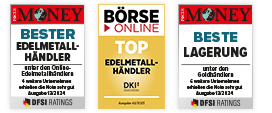Properties of gold and silver
Demand-relevant properties of the precious metals
Silver has an official currency code (XAG) according to ISO 4217.
The many uses of gold and silver are related to their special properties. Gold has a higher melting and boiling point, and its mass and specific gravity are each just under twice that of silver. Silver, on the other hand, surpasses gold - as well as all other metals - in terms of thermal and electrical conductivity, and the same applies to color brightness, polishability and reflectivity. In addition, silver is soft, ductile and malleable, corrosion resistant, tensile, fatigue, wear and heat resistant. It also has antibacterial and antiseptic properties.
Properties of the precious metals gold and silver
| Property | Gold | Silver |
| Atomic number | 79 | 47 |
| Mass | 197 | 108 |
| Melting point | 1065°C | 961°C |
| Boiling point | 2856°C | 2162°C |
| Specific gravity | 19,3 g/cm² | 10,5 g/cm³ |
| Thermal conductivity | 317 W/m/K | 429 W/m/K |
| Electrical conductivity | 42.6 x106 S/m | 62.9 x106 S/m |
Advanced civilizations such as Egypt or India, and in the as yet undiscovered "New World" also the Incas, Mayas and Aztecs, initially used gold and silver primarily for ritual purposes (e.g. as grave goods). The incomparable brilliance of the precious metals and their mantra of immortality elevated them to an almost sacred status. No wonder, then, that they eventually played an exposed and absolutely incomparable role in the decoration of churches as well as in the arts and crafts of jewelry.
Durability, divisibility and rarity are properties that predestine precious metals for another application of great importance, namely as a means of exchange and store of value.[3] For two and a half millennia, gold and silver were the sole authoritative currency, which they are increasingly becoming again against the backdrop of the infirmity of paper currencies (see again the explanations in Chapter 5). As a store of value and an investment, they are of outstanding importance anyway, whether as coins, medals, bars, jewelry, art objects or consumer goods.
Due to its unique physical, chemical and biological properties, silver is also a highly sought-after industrial raw material, which applies to a much lesser extent to gold (see again the comments in Chapter 6). Silver in particular is indispensable for numerous industrial applications, and new areas of application are being discovered all the time. The dynamically growing emerging countries in particular are experiencing rapidly expanding industrial demand.





